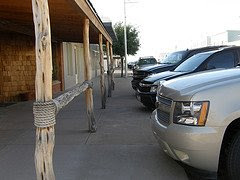Marfa, Texas

The small town of Marfa, Texas was down on its luck after WWII when a useful purpose for a former military/POW camp and munitions factory, among others, stretched the imagination of the remaining population a bit too far. Marfa does have a railroad running through, but is just a bit far from anywhere and lacked other attractions.

 That is until artist Donald Judd chose to invest in the place by turning a number of its old buildings into a permanent exhibition. Judd's own installation in the old munitions factory is a fine collection of aluminum cubes which are much more appealing than anticipated. Light, space, reflection, shadow and illusion were not mentioned in the brief description of the work, but certainly added something. A number of resident artists have contributed to the collection. One memorable one recreates an abandoned Lenin era, Russian schoolhouse, (pictures yet to be uploaded).
That is until artist Donald Judd chose to invest in the place by turning a number of its old buildings into a permanent exhibition. Judd's own installation in the old munitions factory is a fine collection of aluminum cubes which are much more appealing than anticipated. Light, space, reflection, shadow and illusion were not mentioned in the brief description of the work, but certainly added something. A number of resident artists have contributed to the collection. One memorable one recreates an abandoned Lenin era, Russian schoolhouse, (pictures yet to be uploaded).
Now a cartoon in the local paper, 'The Big Bend Sentinel' refers to residents being priced out of the market as it becomes the next Santa Fe. Amusing given that my travel companions are from Santa Fe, and absolutely agree that real estate prices are nowhere near the modest bracket nowadays.

The site now run by the Chinati Foundation is spread across a many acre site with both new and repurposed buildings. It took two hour sessions in the morning and afternoon to get around and that was a just a whistle stop tour. Other sites around the town are life sized installations, an architect's office in a deco style building, a former bank to name just two.

Apart from the life sized installations, Marfa is a pretty little place with the 'grand dame' Presidio County Court House watching over churches of just about every variety and further amusement in the equivalent of the old western style rail for hitchin' horses. The line up is 4X4s today, and it seems a handbrake removes the need for reins.

The accommodation we have chosen for a spot of luxury is the old and beautiful Paesano Hotel which sits on the opposite side of the wide and always semi-deserted main street from a contemporary era opera house. After another 50 yards, the street opens out on both sides to form the square centred by the court house, flanked on one side by a Mexican style church and on another by a deco/colonial style fire station.


The hotel is obviously a popular spot with art-tourists as any of the same people on the Chinati Foundation tour are visible in the warm breezy courtyard at cocktail hour. After sampling the hotel's offering of the trip's signature drink, we head off to take up a recommendation for dinner at the Blue Havelina restaurant. Continuing with the theme, the second round of Margarita's come out a gorgeous shade of pink. Prickly pear pulp is definitely ingredient X, and as well as the best Margaritas so far, the meal is rounded off by the top voted tres leches cake. Maybe they cheated – the waiter told us the recipe uses cuatro leches not tres – but the vote was unanimous that creative interpretation by a chef is definitely allowed!













